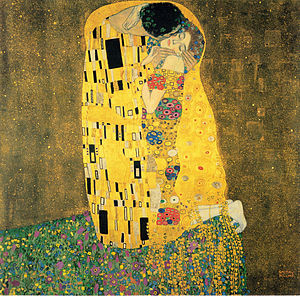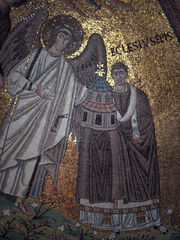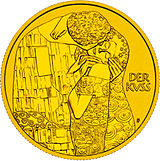- The Kiss (Klimt painting)
-
The Kiss 
Artist Gustav Klimt Year 1907-1908 Type Oil and gold leaf on canvas Dimensions 180 cm × 180 cm (70.9 in × 70.9 in) Location Österreichische Galerie Belvedere, Vienna, Austria The Kiss (original Der Kuss) was painted by Gustav Klimt, and is probably his most famous work. He began work on it in 1907 and it is the highpoint of his so-called 'Golden Period', when he painted a number of works in a similar style. It depicts a couple embracing, their bodies largely hidden by elaborate robes decorated in a style that bears little relation to any historical textile designs. As well as conventional oil paint, gold leaf has been used, one of the aspects of the work that gives it a strikingly modern appearance, while evoking memories of much earlier art. The painting is now in the Österreichische Galerie Belvedere museum, in the Belvedere palace, in Vienna, Austria.
When he painted The Kiss Klimt was 45 and still lived at home with his mother and two unmarried sisters - but behind the respectable facade he was a man with a ferocious sexual appetite. Klimt fathered at least three illegitimate children and probably many more. He was obsessed by women and he had a fixation with redheads. It is no surprise that the woman in The Kiss has red hair. According to writer Frank Whitford: "Together the man and the woman form the shape of a penis and I think that is intentional - it's about sex and about the fulfillment of sex between a man and a woman." [1]
Two figures are situated at the edge of a patch of flowery meadow. The man is wearing a robe with black and white rectangles irregularly placed on a gold background containing spiral decoration, and wears a crown of vines. The woman wears a tight-fitting dress with flower-like round or oval motifs on a background of parallel wavy lines. Her hair is sprinkled with flowers and is worn "up" in the style of the day; it forms a halo-like circle that highlights her face, and is continued under her chin by what seems to be a necklace of flowers. Similarly juxtaposed couples appear in both Klimt’s Beethoven Frieze and Stoclet Frieze.
In The Kiss, Klimt depicted a couple locked in an embrace. The rest of the painting dissolves into shimmering, extravagant flat patterning. This patterning has clear ties to Art Nouveau and to the Arts and Crafts movement and also evokes the conflict between two- and three-dimensionality intrinsic to the work of Degas and other modernists. Paintings such as The Kiss were visual manifestations of fin-de-siecle spirit because they capture a decadence conveyed by opulent and sensuous images. The use of gold leaf recalls medieval "gold-ground" paintings and illuminated manuscripts, and earlier mosaics, and the spiral patterns in the clothes recall Bronze Age art, and the decorative tendrils seen in Western art since before classical times. The man's head ends very close to the top of the canvas, a departure from traditional Western canons that reflects the influence of Japanese prints, as does the very simplified composition.
 Mosaic from San Vitale, Ravenna
Mosaic from San Vitale, Ravenna
Klimt's use of gold had been hugely influenced by a trip he had made to Italy in 1903. He went to Ravenna where he saw the Byzantine mosaics in the Church of San Vitale. For Klimt the flatness of the mosaics and their lack of perspective and depth only enhanced their golden brilliance and he started to make unprecedented use of gold and silver leaf in his own work. [2]
The Kiss is a discreet expression of Klimt’s emphasis on eroticism and the liberation therein. The Kiss falls in line with Klimt’s exploration of fulfillment and the redeeming, transformative power of love and art.[citation needed] The Kiss deviates from Klimt’s frequent portrayal of woman as the lascivious femme fatale. Some think that Klimt and his beloved companion Emilie Flöge modeled for the masterpiece.[3] Another suggestion has been that she was a model called 'Red Hilda.' There is strong visual evidence that she is the model for 'Woman with feather boa' , 'Goldfish' and 'Danaë'. She told her nephew that she was the woman in 'The Kiss'.
 The painting coin featuring "The Kiss"
The painting coin featuring "The Kiss"
Gustav Klimt and "The Kiss" were selected as the main motif for a collectors' coin, the 100 euro gold The Painting coin issued on 5 November 2003. The obverse depicts Klimt in his studio with two unfinished masterpieces on easels, while the reverse shows "Der Kuss" (The Kiss). A 3D bronze sculpture representing the figures in the painting, by the Russian sculptor Aleksander Taratynov, is installed in the Oranienbaum park near Saint Petersburg in Russia.[4]
References
External links
- Gustav Klimt at the Österreichische Galerie Belvedere
- Der Kuss
- The Kiss at 100
- Google books search
Categories:- 1907 paintings
- Gustav Klimt paintings
Wikimedia Foundation. 2010.
